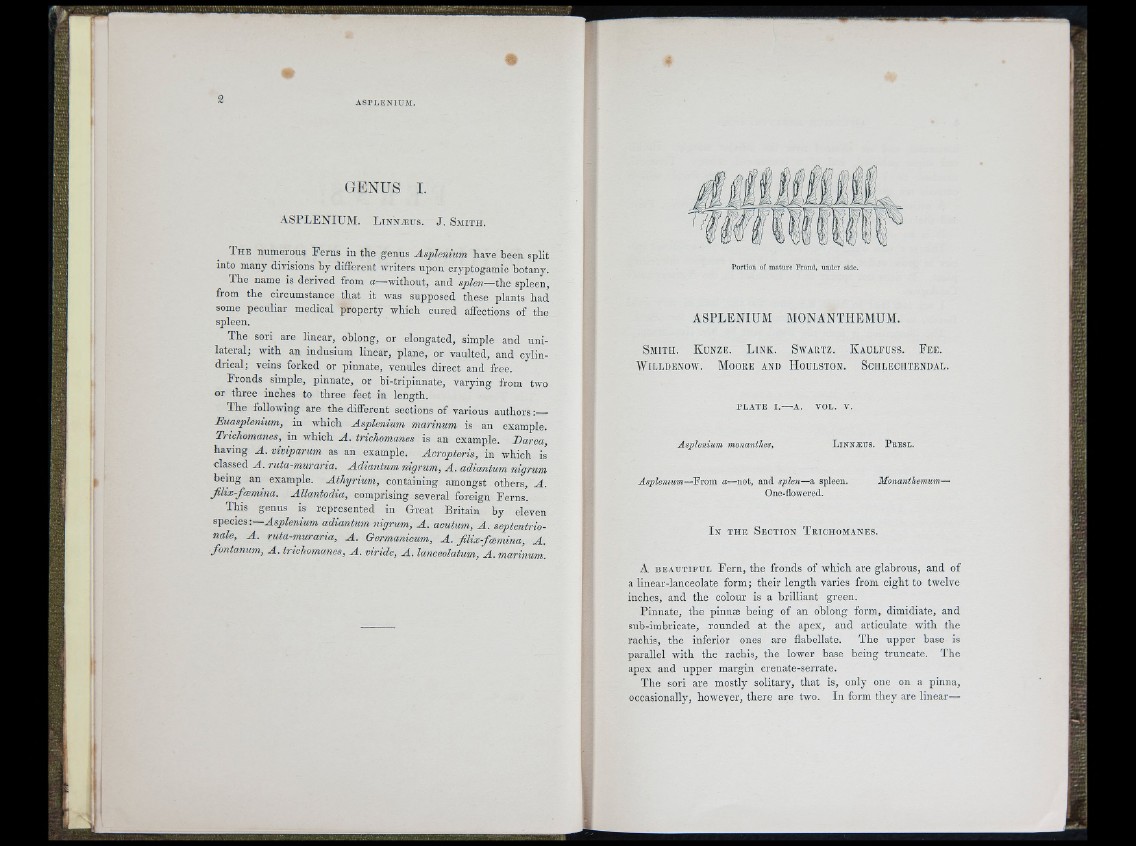
( Î E N U S 1.
A SPL EN IUM . L in n æ u s . J. S m i t h .
T h e numerous Ferns in the genus Asplénium, have been split
into many divisions by different writers upon cryptogamie botany.
The name is derived from a—without, and splen—'Oac spleen,
from the circumstance that it was supposed these plants had
some peculiar medical property which cured affections of the
spleen.
The sori are linear, oblong, or elongated, simple and unilateral;
with an indusium linear, plane, or vaulted, and cylindrical;
veins forked or pinnate, venules direct and free.
Fronds simple, pinnate, or bi-tripinnate, varying from two
or three inches to three feet in length.
The following are the different sections of various authors :__
Euasplenium, in which Asplénium marinum is an example.
Trichomanes, in which A . trichomanes is an example. Barea,
having A . mviparum as an example. Acropteris, in which is
classed A . ruta-murana. Adiantum nigrum, A . adiantum nigrum
being an example. A th y rium, containing amongst others, A .
Jilix-fæmina. Allantodia, comprising several foreign Ferns.
This genus is represented in Great Britain by eleven
species:—AsgAenium adiantum nigrum, A . acutum, A . septentrionale,
A . ruta-muraria, A . Germanicum, A . Jilix-fæmina, A .
fontanum, A . trichomanes, A . viride, A . lanceolatum, A . marinum.
w f l l i l i
Portion of mature Frond, under side.
ASPLENIUM MONANTHEMUM.
Sm ith . K unze. L in k . Swartz. K aulfuss. F e e .
WiLLDENOw. Moore and I I ohlston. Sciileciitendal.
PLATE I .— A. VOL. V.
denium monanthes. L in n æ u s . P b e s l .
Asp îen ium—^From a—not, and splcn—a spleen. Monanthemum-
One-flowered.
I n t h e S e c t io n T r ic h o m a n e s .
A b e a u t i f u l Fern, the fronds of which are glabrous, and of
a linear-lanceolate form; their length varies from eight to twelve
inches, and the colour is a brilliant green.
Pinnate, the pinuæ being of an oblong form, dimidiate, and
sub-imbricate, rounded at the apex, and articulate with the
rachis, the inferior ones are flabellate. The upper base is
parallel with the rachis, the lower base being truncate. The
apex and upper margin crenate-serrate.
The sori are mostly solitary, that is, only one on a pinna,
occasionally, however, there are two. In form they arc linear—